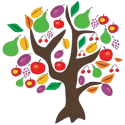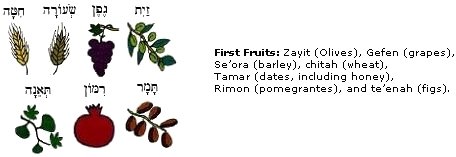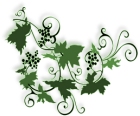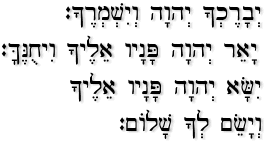|
|
|||||||||||||||||||||
 |
|||||||||||||||||||||
|
Learn Hebrew |
|||||||||||||||||||||
|
|
||||||||||||||||||||||||||||||||||
|
Originally Tu B'Shevat marked the date for calculating the tithes of the harvest (ma'aserot) that families would pledge to the priests of Israel. After the destruction of the Second Temple, however, it was no longer possible to offer agricultural tithes, and among Diaspora Jews it became customary to commemorate this time by eating "the Seven Species" (i.e., shivat ha-minim: ū®ūüų┤ūæų░ūóųĘū¬ ūöųĘū×ų╝ų┤ūÖūĀų┤ūÖūØ), that is, the seven types of grains and fruits listed in the Torah as being special products of the Land of Israel (Deut. 8:8). These seven types of produce include wheat, barley, grapes, figs, pomegranates, olives, and dates. Later still, in the 16th century, Rabbi Isaac Luria of Tzefat developed a Passover-like Seder featuring wine and the "seven species" of the Land of Israel to commemorate the holiday of Tu B'Shevat. Today the Tu B'Shevat Seder can anticipate the coming of spring...
Like other Jewish holidays, Tu B'Shevat begins 18 minutes before sunset, that is, just before the start of Shevat 15. When Tu B'Shevat falls on the Sabbath, however, the seder is performed as part of the Sabbath meal, that is, after welcoming the Sabbath. |
|
What You'll Need... |
|||||
|
To perform your own Tu B'Shevat home ceremony/seder, you'll need the following:
|
|||||
 |
|||||
|
Seder Overview |
|||||
|
Four cups of wine (or grape juice) are used to symbolize the different agricultural seasons of the year. Each cup will be made a different color based on the mixture of white and red juices, symbolically depicting the changing seasons and colors of the year: from wintery white to a touch of spring red, from rosy summer to the full redness of autumn. |
|
Basic Seder Steps: |
|
1. Light the Yom Tov Candles We begin by lighting the holiday candles (18 minutes before sunset) and reciting the Yom Tov blessing at this time (unless it is Shabbat, in which case we light the Sabbath candles instead and then add the Yom Tov addition). Note: Some people maintain that this holiday does not require candle lighting, since Tu B'Shevat is not a "major festival" that requires the complete cessation of profane work (ū®ūüųĘūæų╝ųĘū¬ ū®ūüųĘūæų╝ųĖū¬ūĢų╣ū¤). However, since candle-lighting is a customary way to sanctify time, we recommend lighting candles anyway, especially since we are not followers of the rabbis but rather Yeshua, who is the Light of the World and the Tree of Life... 2. Pour the First Cup (Kiddush) We fill our cups with white grape juice. This first cup represents winter, and the Hebrew blessing (hagafen) is recited over the poured cup. We drink from the First Cup at this time. 3. Eating Fruit of the Trees The first plate of fruit (i.e., the one holding fruits with one large pit or seed) is then passed around the table and the Hebrew blessing over fruit trees is recited (borei pri ha'etz). Everyone then eats some of the fruits and almonds. 4. Reciting Shehecheyanu Since this marks the first taste of fruit for the new year of trees, the Shehecheyanu blessing is also recited at this time. 5. Eating Fruit of the Earth After this, the second plate of fruit (i.e., the one holding fruits with many seeds) is passed around the table and the Hebrew blessing (ha'adamah) is recited. Again, everyone samples some of these fruits. In addition, we taste some wheat and barely crackers at this time. 6. Drinking the Second Cup A few drops of red juice are added to the cups of white juice and the change in color is observed. This is meant to symbolize both the changes of the season and to remind us that from small seeds large things can come (Matt. 13:31-32). We recite the Hebrew blessing (hagafen) again and then drink from the second cup of juice. 7. "Planting Seeds" Because it represents the New Year for Trees (Rosh Hashanah L'ilanot), we pass around a bowl of graham cracker crumbs (symbolizing soil) and "plant" symbolic seeds (e.g., almonds, raisins) using a spoon. Others at the table "water" the seeds using chocolate syrup or honey. This is done to remind ourselves of the importance of planting good seed in our lives and to water the seeds of others (see Psalm 126:5-6; Matt. 13:23, Matt. 20:1-16, Mark 4:26-29, 1 Cor. 3:8-9). Everyone then partakes of some of this "desert." 8. Giving a D'var Torah During the Tu B'Shevat seder we recall the various parables involving agricultural growth and fertility in Yeshua's teaching. For example, Yeshua taught: "Unless a grain of wheat falls into the earth and dies, it remains alone; but if it dies, it bears much fruit" (John 12:24). The death of the outer shell of the seed leads to the growth of the seed into new life: "What is the Kingdom of God like? To what shall I compare it? It is like a grain of mustard seed, which a man took, and put in his own garden. It grew, and became a large tree, and the birds of the sky lodged in its branches" (Luke 13:18-19). In John 15:5, the expression "apart from me" (ŽćŽēŽüßĮČŽé ß╝É╬╝╬┐ß┐”) means being in a state of separation from Yeshua, which is likened to spiritual death... It is the death of possibility, the absence of power to yield true good to the world, and so on. This is what is meant by "you can do nothing" (╬┐ßĮÉ ╬┤ßĮ╗╬Į╬▒Žā╬Ė╬Ą ŽĆ╬┐╬╣╬Ąß┐¢╬Į ╬┐ßĮÉ╬┤ßĮ│╬Į), that is, you can do nothing of any eternal significance or worth... There is simply no true life apart from the Savior. 9. Drinking the Third Cup We add some more red juice to our cups to create a rosy blend of about half white and half red grape juice. This again symbolizes the passing of the seasons and reminds us of the need to share our lives with one another. We again recite the Hebrew blessing (hagafen) and then drink the third cup. 10. Drinking the Fourth Cup The last cup is then filled entirely with red juice. This cup is said to symbolize the fulness of life and God's blessing. As we contemplate the changing seasons, the increase of color, the deepening hues, we remember the sacrificial blood of Yeshua that was shed so that we can live fruitful lives before the Father... We recite the Hebrew blessing (hagafen) again and then drink from the cup. 11. Offering a Closing Prayer We begin to conclude our Tu B'Shevat Seder by asking God to help us to grow and be productive in the coming days. We ask for the fruit of the Holy Spirit (ūżų╝ų░ū©ų┤ūÖ ūöųĖū©ūĢų╝ūŚųĘ) to be manifest in our lives, and we especially appeal to the LORD to equip us to be co-laborers with Him in the great vineyard of the world... The following prayer may also be recited: ūÖų░ūöų┤ūÖ ū©ųĖū”ūĢų╣ū¤ ū×ų┤ū£ų╝ų░ūżųĖūĀųČūÖūÜųĖ ūÖūöūĢūö ūÉų▒ū£ūöųĄūÖūĀūĢų╝ ūĢųĄūÉū£ūöųĄūÖ ūÉų▓ūæūĢų╣ū¬ųĄūÖūĀūĢų╝ ye┬Ęhee ┬Ę ra┬Ętzon ┬Ę meel┬Ęfa┬Ęney'┬Ękha ┬Ę Adonai ┬Ę E┬Ęlo┬Ęhey'┬Ęnoo ┬Ę ve┬Ęlo┬Ęhey ┬Ę a┬Ęvo┬Ętey'┬Ęnoo "May it be Your will, LORD our God and God of our fathers, 12. Reciting the Closing Blessing The priestly blessing is found in Numbers 6:23-27. Traditionally, the priests blessed the people every morning after the sacrifice at the Temple. Today, many people recite this blessing as a benediction for special occasions. |
|
|
|
||||||||||||||||||||||||||||||||||||||||||||||||||||||||||||||||||||||||||||||||||||||||||||||||||||||||||||||||||||||||||||||||||||||||||||||||||||||||||||||||||||||||||||||||||||||||||||||||||||||||||||||||||||||||||||||||||||||||||||||||||||||||||||||||||||||||||||||||||||||||||||||||||||||||||||||||||||||||||||||||||||||||||
|
Hebrew for Christians |
|||||
|
|||||








